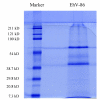Proteomic analysis of the EhV-86 virion
- PMID: 18346272
- PMCID: PMC2322966
- DOI: 10.1186/1477-5956-6-11
Proteomic analysis of the EhV-86 virion
Abstract
Background: Emiliania huxleyi virus 86 (EhV-86) is the type species of the genus Coccolithovirus within the family Phycodnaviridae. The fully sequenced 407,339 bp genome is predicted to encode 473 protein coding sequences (CDSs) and is the largest Phycodnaviridae sequenced to date. The majority of EhV-86 CDSs exhibit no similarity to proteins in the public databases.
Results: Proteomic analysis by 1-DE and then LC-MS/MS determined that the virion of EhV-86 is composed of at least 28 proteins, 23 of which are predicted to be membrane proteins. Besides the major capsid protein, putative function can be assigned to 4 other components of the virion: two lectin proteins, a thioredoxin and a serine/threonine protein kinase.
Conclusion: This study represents the first steps toward the identification of the protein components that make up the EhV-86 virion. Aside from the major capsid protein, whose function in the virion is well known and defined, the nature of the other proteins suggest roles involved with viral budding, caspase activation, signalling, anti-oxidation, virus adsorption and host range determination.
Figures
References
-
- Westbroek P, Brown CW, Vanbleijswijk J, Brownlee C, Brummer GJ, Conte M, Egge J, Fernandez E, Jordan R, Knappertsbusch M, et al. A Model System Approach to Biological Climate Forcing – the Example of Emiliania huxleyi. Global and Planetary Change. 1993;8:27–46. doi: 10.1016/0921-8181(93)90061-R. - DOI
-
- Westbroek P, vanHinte JE, Brummer GJ, Veldhuis M, Brownlee C, Green JC, Harris R, Heimdal BR. Emiliania huxleyi as a key to biosphere-geoshere interactions. In: Green JC, Leadbeater BSC, editor. The Haptophyte Algae. Vol. 51. Oxford: Clarendon Press; 1994. pp. 321–334.
-
- Wilson WH, Van Etten JL, Schroeder DS, Nagasaki K, Brussaard C, Delaroque N, Bratbak G, Suttle C. Family: Phycodnaviridae. In: Fauquet CM, Mayo MA, Maniloff J, Dusselberger U, Ball LA, editor. Virus Taxonomy, VIIIth ICTV Report. London: Elsevier/Academic Press; 2005. pp. 163–175.
LinkOut - more resources
Full Text Sources
Other Literature Sources


